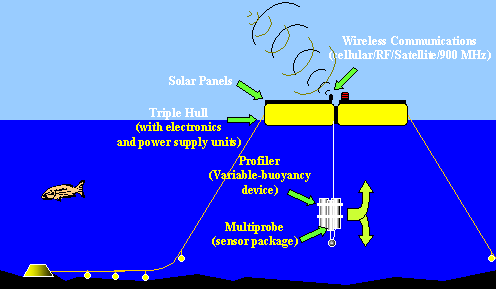Water Monitoring
What to Monitor:
Dissolved Oxygen (DO)
Fecal Coliform (bacteria derived from warm-blooded animal feces)
pH
Biological Oxygen Demand / Carbonaceous Biological Oxygen Demand
(BOD/CBOD)
Temperature
Conductivity
Total Phosphorus
Nitrates
Total Kjeldal Nitrogen
Turbidity
Benthic Macroinvertebrates (Biological Indicators)
Salinity
(Look at the source to read why it is important to monitor each of
these, except Total Kjeldahl Nitrogen, which is important because
Nitrogen is a fertilizer like Phosphorus, and salinity, since salt
water is being tested.)
Source:
Mississippi Headwaters Board. "Water Quality Monitoring Plan: Summary
of Water Indicators."
http://www.mhbriverwatch.dst.mn.us/river_watch/plan.html
How To Monitor It:
Water will be monitored through a "Remote Underwater Sampling System
(RUSS)," similar to the one below, which is used in Northern Minnesota
Lakes:

(Interactive Technologies for Collecting and Visulizing Water Data)
This is a floating platform which collects and analyzes data about the
water quality and then sends it to a sattelite or remote station for
further analysis and recording. It could be anchored in the ocean and
left to its own devices, or let drift and picked up later. Its solar
panels allow it to remain autonomous for an indefinite period of time.
One of its limitations in an application to an ocean environment would
be that since the anchor it disturbs the sea floor, it would have to
drift over coral reefs in order to monitor them. Even then, there would
be a risk that the sensor package would hit the reef. Therefore, more
conventional sampling methods (i.e. humans gathering samples) or the
use of small floating motes with lightweight probes that do not extend
deep enough to hit the coral, and will not hurt them even if they do,
would probably be more viable options for reef monitoring.
Further information on the RUSS can be found at the source page.
Source:
Host, George E.,
Will, Norman R., Axler, Richard P., Owen, Christopher J., Munson, Bruce
H. Interactive Technologies
for Collecting and Visulizing Water Data.
Found Online at: http://wow.nrri.umn.edu/urisa/#_ftn1